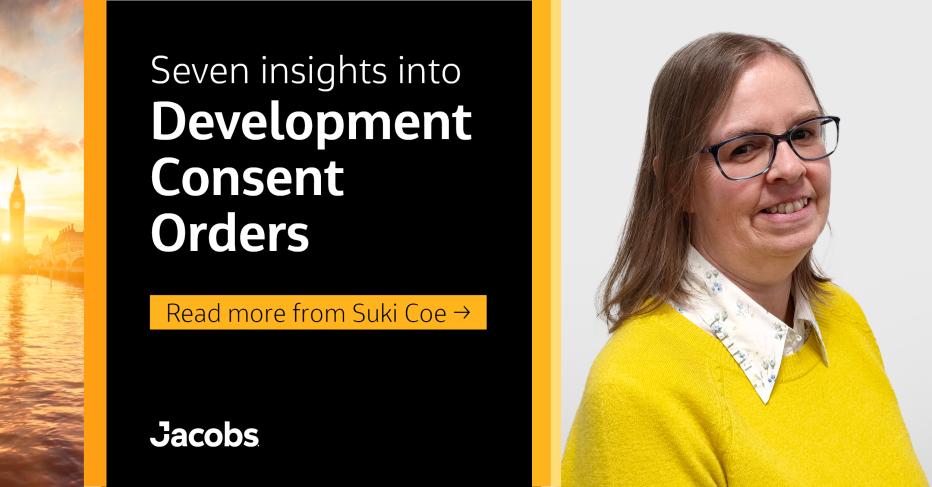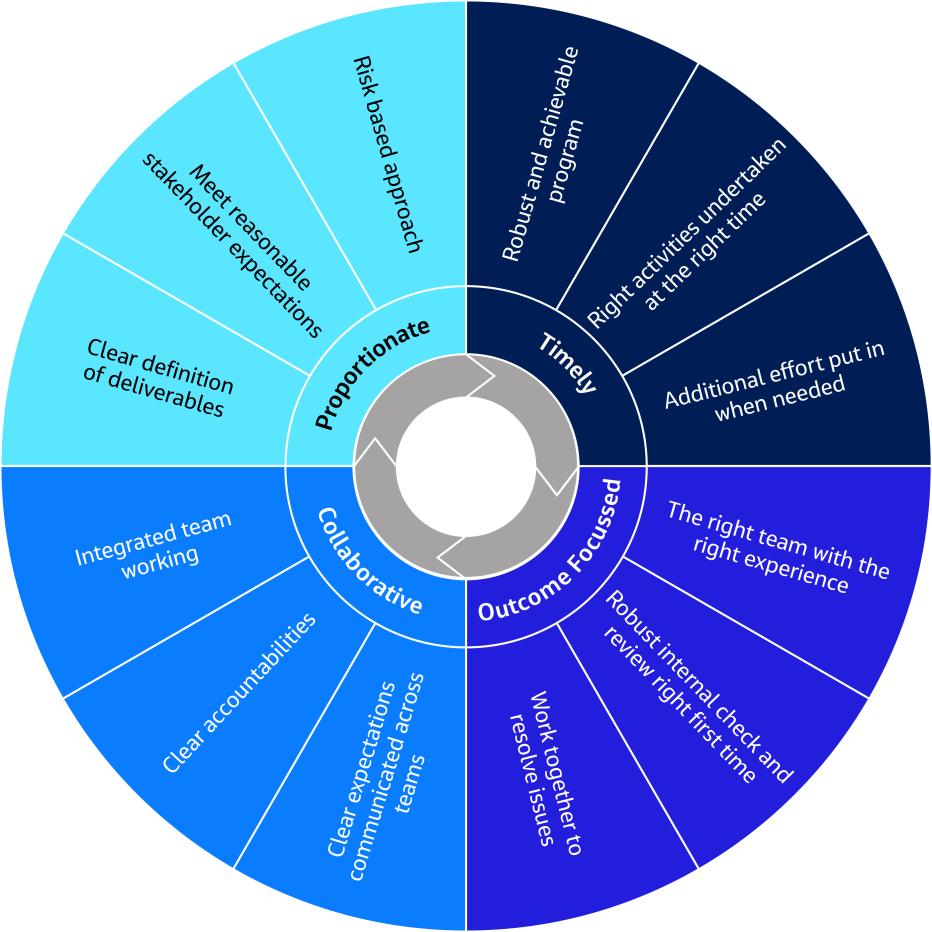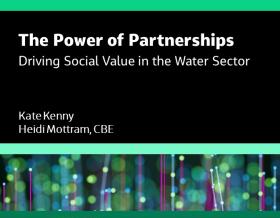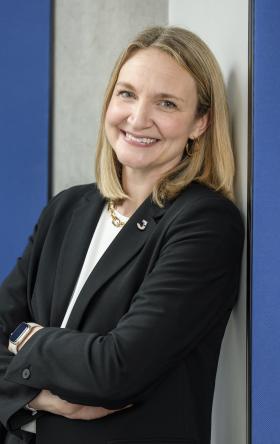The Balancing Act: Embracing Innovation and Risk in Major Infrastructure Planning
Our Senior Associate Director Suki Coe shares her seven insights for Development Consent Order success.

By their design, Development Consent Orders (DCOs) help resolve complex issues in Nationally Significant Infrastructure Projects (NSIPs) or major programs that rely on public consent, engagement and land acquisition. Created through the Planning Act of 2008 by the government, securing DCOs is a marathon, not a sprint — if we were seeking to solve an easy problem, a DCO wouldn’t be needed. NSIPs have thousands of moving parts and typically require incredibly high stakeholder engagement and collaboration levels. The secret to DCO success is transparency, honesty, silo-busting teamwork and empowering early engagement among the whole project team — the earlier, the better. If you get that right, you can create a simple and flexible delivery approach, one that’s focused on proportionality, timeliness and collaboration.
Why should we have a bigger focus on DCOs now? The U.K. is ramping up its NSIPs ambition — according to the Government, there has been a 40% increase in major infrastructure projects going through the NSIPs system since 2020. Aligned with this growth is the dire need to make decisions faster: the NSIPs Action Plan has recognized that over half of decisions now have delays, with the average one lasting nine months, which has tremendous cost and community impact.
Outside of task forces and national frameworks, delivery partners must build effective, multidisciplinary teams that use cross-sector insights and global teams to drive productivity. As one of the DCO team leaders at Jacobs, I’ve been privileged to work with talented and award-winning teams on past and current major projects such as Tideway and Lower Thames Crossing. We combine deep sector knowledge, comprehensive skills and leading program management expertise to efficiently deliver robust and practical DCOs that support project business cases. These are my seven lessons in creating a successful DCO.
- Don’t aim for perfection initially; focus on collective ownership and total engagement.
Like all large-scale challenges, DCOs require breaking down into smaller sections, each involving sign-off and stakeholder engagement. In my experience, after all parties agree on the scope and objectives of the project, the design solution is a pivotal step. In almost all cases, this will require negotiation and compromise, and as a result, it won’t be perfect — but the key is to rally support from all parties.
This ties into my overall approach with these projects: recognize the difficulty and complexity, ensure everyone is heard and engaged and start pulling together in the same direction. I call this ‘managing the chaos,’ as you must empower all the disciplines to have their input. It can generate a lot of noise and feel chaotic, but it builds collective ownership and the confidence to tackle what’s next.
One of the challenges within this is not to let a specific discipline lead the project. Our teams are filled with specialists and subject matter experts, from chartered town planners and consultation advisers to engineering and environmental specialists. In my experience, project teams struggle if a particular discipline leads them. For example, if it’s led by the consenting team, it becomes biased toward that discipline. It may either miss important considerations or be unable to drive as much collaboration. It’s about setting aside perspectives — which may require putting the crown to the side a little — and recognizing that everyone has something to contribute.
- Understand what your client’s risk approach is.
Harnessing innovation is by its nature untested, as many of the techniques or technologies haven’t been used widely. That has the potential to drive up risk and cost, and this is where you need to support your clients to make these decisions. This is where you need to inform your clients about the risks involved. Understanding your client’s risk profile has a double benefit: you empower your client and strengthen your relationship. At times, clients will need to increase their risk appetite to overcome specific challenges. The earlier you understand your client’s risk profile, the more successful your relationship will be in managing the significant and often daunting challenges in DCOs.
One example of this innovation and risk relationship can be found in challenging your client to follow sustainable construction practices. This can include using hydrogen, lower-carbon concrete and land optimization strategies to create more benefits for our communities and environment. As these are cutting-edge techniques and materials that are still new to the market, it can potentially increase risk. However, even though some of these approaches haven’t been widely used or are more costly than traditional approaches, it shouldn’t stop us from embracing an ambitious sustainability agenda that will deliver more environmental improvements and social value benefits.
- Invest in your current (and future) team.
One of the most significant challenges in DCO work for the client and partners is having both capacity and capability throughout the project timeline. Attracting excellent talent into our professions is a challenge, but the complexity of DCO projects adds another dimension of difficulty.
One of the solutions here is to remove the misperceived fear and myths surrounding DCO work, as even though it is difficult work, it’s also rewarding and offers immense upskilling and experience gains. Part of this solution relies on external education, but it also comes down to how you treat your teams internally — and this includes safety, enjoyment, work-life satisfaction and mental wellbeing.
It’s a question of providing constant and unwavering support. If someone on your team has a tough time finding a resolution in their field, our team rallies to find a way through, as we believe in the project and its people. No one is ever left to face the pressure alone, whether from the public or the examining authority. It requires building solid behavioral foundations and creating the right team dynamic. These projects impact on our colleagues’ home lives, as they work at a high pace under pressure and away from their homes for long periods.
This also requires two things on an individual level. Before you can successfully support your team members, you need to know your personal stress triggers (mental and physical) and your limits. You will need to step back and recover at some phases of the project. Secondly, you must work to your strengths and communicate them so your team can integrate them into the combined resources and capabilities.
- Drive innovation in community contributions for better consultations.
One of the most significant challenges within DCOs is ensuring the application is fit for purpose after doing stakeholder engagement. In many cases, clients don’t fully understand the social value and responsibility required on their behalf to help gain approval for projects that disrupt local communities. Case in point: if you were building a new motorway that affected several farms and a local village, it requires that the client, and by extension, you as a delivery partner, do something about it.
It starts with clear stakeholder engagement and owning the changes needed, not shirking from the responsibility or becoming inactive due to negative media attention. Companies need to explain the motivation behind the planned changes and why it will be better nationally after the localized disruption. Unfortunately, in many cases, the individuals who are disrupted by your plans are often people who aren’t going to benefit from your new highway, like, for example, the local community in the way of the planned motorway.
In other words, it can be a tough sell, so clients must understand and be prepared to actively listen to those who will be disrupted and offer other creative solutions to lessen the impact. Is it about using environmental mitigation to do something positive, like creating a new park or improved active travel route, or is it about employing local people and upskilling them through the program? Can I support the local health services by organizing an extra dentist and a doctor to be available in the area for the next 10 years? This is where you need to think outside the box to offer social value to the disrupted communities.
- Don’t underestimate the silent majority.
In DCOs, you and your clients will face high levels of political and policy challenge, risk and uncertainty. To overcome this, you must keep your eye on the ultimate goal in the national interest. Unfortunately, you will encounter public opposition, and in most cases, this will include a local resistance group that won’t necessarily have logical, rational or reasonable motivations for their opposition.
The best way to handle these opposition players is to remember the NSIP purpose. Your positive overall impact and national significance of your project will outweigh the loud negativity of a group of objectors who, in some cases, are unlikely to be satisfied. We tend to forget the silent majority that we’re helping as they aren’t engaging heavily in the stakeholder sessions. This advice is particularly pertinent for clients who get nervous with negative stakeholder responses and publicity.
My advice here is two-fold: don’t lose the support of your key stakeholders, even if they’re mostly silent. Winning them back requires a lot of effort, time and money. This relies on knowing your main stakeholders as a starting point and identifying your allies. By working with them, you can help influence your objectors. Aligned with this, you can also use the momentum of some of your more prominent stakeholders to maintain your project momentum. This aligns with the strength of knowing which partnerships to use at what time.
The bottom line is that if you have the right aims and objectives, and have outlined a sound design, you collectively need to get your shoulder behind it and make it work. While you must listen to every stakeholder, you must keep your perspective: you can’t get distracted and delayed by objectors who will never be satisfied, no matter how creative or effective your mitigation and adaptation strategies are.
- Technology empowers decision-making and team performance.
We use cutting-edge technology in our DCO work, from survey drones to digital Environmental Impact Assessment (EIA) platforms, but there are smarter experts than me in Jacobs doing amazing things using tech in the air, underwater and on the ground, who can speak at length about this. Our chartered town planners and consultation advisers are integrated into our teams of engineering and environmental specialists. This enables us to offer a truly comprehensive understanding of what is required for a successful DCO submission.

Our approach to DCOs is collaborative, outcome-focused, proportionate and timely
However, from my side, technology's two greatest benefits in DCO work are offering a non-stop, global workforce and linking spatial data for stakeholders.
In the first instance, we’ve upgraded how we work together worldwide. We no longer need to be physically located together; we're collaborating in real time, sharing data, and making more empowered decisions. It’s a massive advantage, especially when working on finite examination time scales where we can’t miss a deadline. We even use a relay system where we use resources in America and Poland to extend our working day. In some cases, I've used our resources in Australia to pick up on my work overnight, and then I resume their contribution once I’m back online in the morning. It creates a seamless 24-hour production line, which we’ve used on several major projects. The best part? We’re not extending anyone’s regular working hours; we’re just leveraging our global talent.
The second benefit is that our technology links spatial data to people or stakeholder data. Here’s an example: if Farmer Jones owns a piece of land within our proposed project area, we must collect data about it. He may oppose the project and won't give access to our survey teams. We need to understand where the farmer stands, investigate any past interactions and find information that could help explain the farmer’s motivation. For example, have they had negative experiences with previous projects? Have previous commitments let the farmer down? All this data could help inform how we can resolve the issue or if we need to bypass their land — there may be a smart mitigation or adaptation solution.
This is where technology like Track Record, Project Mapper and our DCO toolkits are critical, as we need to record and present data carefully in real time. It needs to cover everything, including statements of common ground through land agreements, responses, and relevant representations throughout the consenting process. If you don’t do this, you won’t be able to effectively negotiate with Farmer Jones.
- Focus on what and how to turn carbon challenges into opportunities.
These NSIPs usually require massive infrastructure builds, so the carbon costs are high and rightly hard to justify. You need to create a water-tight and compelling argument for the need for this project, and then you must invest high levels of time and effort into a construction decarbonization plan. It’s not just about using materials such as lower-carbon concrete and modularization; it also requires nature-based solutions, biodiversity opportunities and innovation-led sustainability. Everything needs to be questioned and measured, from the fuel used in construction to the system that delivers and removes materials for the machines. Crucially, the significant carbon savings aren’t all in what materials you use but in how you build and do things.
Delivering a successful DCO demands collaboration and innovation, but it all relies on a foundation of working from a shared understanding of goals and objectives. Every single team member must be aligned and integrated, and you all need to understand the greater policy context you operate in: what is the bigger picture, and how does your project fit within that? The final takeaway comes down to the consultation and engagement with stakeholders and interested partners — it needs to be robust and thorough, but also offers the space to be creative and innovative.
About the author

Suki Coe is a Chartered Town Planner with over 30 years' experience in local and national government and consultancy. She has taken a leading role in the consenting of several NSIPs through the DCO consenting process, including Lower Thames Crossing.
You might be interested in...
Future Foundations.
Co-creating the world to come

From developing climate resilience and transitioning to a low-carbon future, to modernizing and transforming infrastructure, governments and businesses face critical challenges. How they respond will define our future.
As our clients navigate these challenges, we help them think differently – working together to pioneer tomorrow's infrastructure solutions and build the foundations for a prosperous, secure future.

















































